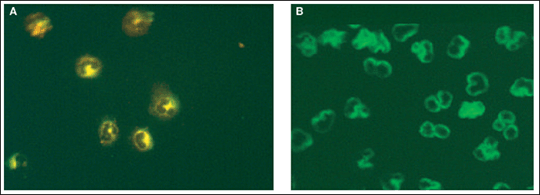Note – Interpretation of blood test results Normal ranges differ between different hospital laboratories and may not be comparable. Therefore, blood results should be discussed with the medical team.
Alkaline phosphatase (Alk. Phos)
Alkaline phosphatase is an enzyme made in the liver, bone, and the placenta and normally present in high concentrations when during growth. Alkaline phosphatase is released into the blood during injury and during bone growth and pregnancy. Abnormally high blood levels may indicate disease, eg in the liver or bones.
Antineutrophil Cytoplasmic Antibodies (ANCA)
Autoantibodies which are usually found in patients with the ANCA associated vasculitides but can also be found in other inflammatory diseases (particularly inflammatory bowel disease), some infections and occasionally in entirely healthy people.
There are two main types of ANCA found in people with vasculitis called c-ANCA (which is usually the same as anti-proteinase 3 or anti-PR3 ANCA) and p-ANCA (which is usually the same as anti-myeloperoxidase or anti-MPO ANCA). One of the main tests for ANCA involves looking down a microscope at neutrophils to see where the ANCA is sticking to the neutrophil. Using this test the c-ANCA (picture A) and p-ANCA (picture B) look different as below.

c-ANCA is more commonly found in patients with Wegener’s granulomatosis (also called granulomatosis with polyangiitis) and p-ANCA is more common in microscopic polyangiitis although either can be found in both diseases. People with Churg-Strauss Syndrome may have p-ANCA or c-ANCA or no ANCA at all.
Aspartate Aminotransferase (AST)
AST is an enzyme found in heart muscle, liver and skeletal muscle cells. To a lesser extent it is found in other tissues. Raised levels can be found following damage to the heart, liver or muscles.
Creatinine
Creatinine is measured in the blood as a measure of kidney function. Creatinine is released into the blood mainly from muscle cells and is removed by the kidneys. In general the higher the creatinine level in the blood the worse the kidney function is. Creatinine has several serious limitations for measuring kidney function. It varies hugely from patient to patient even when the kidney function is the same. The level in the blood is also dependent on the age, gender, body size, muscle mass and diet of the patient. It is also possible to have normal creatinine levels in the blood with very abnormal kidney function. Sometimes it is also possible to have abnormal creatinine levels with normal kidney function.
Because of these limitations most doctors now measure kidney function as the estimated glomerular filtration rate (eGFR) which can be more reliable.
C-Reactive protein (CRP)
C-reactive protein is produced by the liver. The level of CRP usually rises when there is inflammation present although this is not specific for vasculitis and can also indicate infection or other problems.
Erythrocyte sedimentation test (ESR)
ESR is a test that indirectly measures how much inflammation is in the body.
Haemoglobin (Hb)
Haemoglobin is a protein in red blood cells that carries oxygen. Measuring the Hb level is useful to detect a low red blood cell count (anaemia).
Platelets
Platelets assist in blood clotting. During normal blood clotting, the platelets clump together. Although platelets are often classed as blood cells they are more accurately fragments of large bone marrow cells called megakaryocytes. The platelets are usually measured as one of the measures of bone marrow function. Very low levels can increase the risk of bleeding. High levels can occur if inflammation is present.
White blood count (WBC)
White blood cells (also called leukocytes) are an important part of the immune system. The cells help fight infections and also monitor the body for the development of early cancer cells which they destroy. They also have an important role in the inflammation which occurs in vasculitis which leads to organ damage. There are five major types of white blood cells: Basophils, Eosinophils, Lymphocytes (T and B cells), Monocytes, and Neutrophils which all have different roles in the body. Monitoring the WBC is important for patients on immunosuppressant drugs as a low WBC can be caused by many of these drugs and can lead to infection if the immune system is over suppressed.
